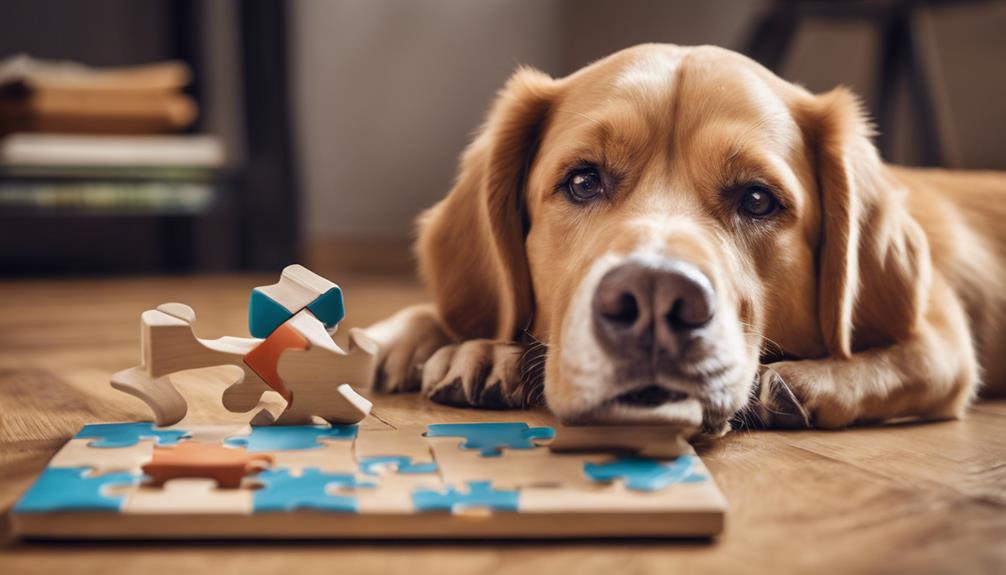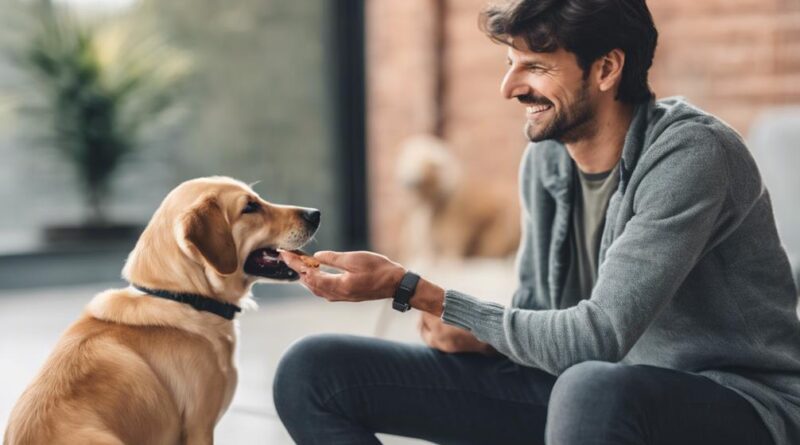10 Insights Into Dog Psychology for Improved Bonding
Do you ever feel like you're missing out on a deeper connection with your furry companion?
Understanding the intricate workings of dog psychology can truly transform your bond with your four-legged friend.
From decoding their communication signals to tapping into their complex cognitive abilities, there's a whole world of insights waiting to be explored.
By unraveling these mysteries, you might just uncover the key to a more enriching and fulfilling relationship with your canine companion.
Canine Communication Signals
When observing dogs, understanding their body language and vocalizations can provide valuable insights into their emotions and intentions. Dogs communicate not only through barks and whines but also through a variety of nonverbal cues. Pay attention to their body language, such as wagging tails, relaxed postures, or raised fur, to gauge their mood and feelings.
For example, a tucked tail may indicate fear or submission, while a confident dog typically holds its tail high. Vocalizations also play a crucial role in canine communication. Different barks can signify various emotions, from excitement during play behavior to warning signals when feeling threatened.
Understanding Pack Dynamics
To grasp the dynamics within a dog pack, observe their interactions closely. Dogs exhibit a pack mentality, relying on a structured hierarchy to maintain order and cohesion. Understanding their pack dynamics can help you better comprehend your furry companion's behavior.
- Dominance Display: In a dog pack, there's often a display of dominance where certain individuals assert themselves as leaders. This can involve body language, vocalizations, and physical actions to establish authority.
- Submission Signals: Dogs also communicate submissiveness within the pack to show respect to higher-ranking members. This can include lowering their body, averting eye contact, and even offering playful gestures to indicate their subordinate role.
- Social Bonding: Pack dynamics play a crucial role in fostering social bonds among dogs. Through shared activities, mutual grooming, and coordinated movements, dogs strengthen their connections and sense of belonging within the pack.
Instinctual Behavior Patterns
Observing the instinctual behavior patterns in dogs unveils the innate drives and inclinations that govern their actions within the pack dynamic. Dogs exhibit a prey drive, a natural instinct to hunt and capture prey, which is a trait inherited from their wild ancestors. This drive can manifest during play or when they chase smaller animals. Additionally, territorial instincts are deeply rooted in a dog's behavior, leading them to mark their territory and protect it from intruders.
Pack hunting is another instinctual behavior pattern seen in dogs, where they work together to capture food. This behavior stems from their ancestors who relied on group hunting for survival. Even in domestic settings, dogs may exhibit pack hunting tendencies when playing or engaging in activities with other dogs.
Survival strategies are ingrained in a dog's instincts, guiding them on how to find food, shelter, and protect themselves from perceived threats. Understanding these instinctual behavior patterns can help you comprehend your dog's actions and strengthen your bond by catering to their natural inclinations.
The Role of Scent in Bonding
Engaging with your dog's unique scent preferences can deepen the bond between you both. Dogs have an incredible sense of smell, and by understanding and embracing this aspect of their nature, you can enhance your relationship in profound ways. When you acknowledge and cater to your dog's scent preferences, you're actively participating in a form of communication that's deeply meaningful to them.
- Scent recognition: Dogs have the ability to identify individuals, other animals, and even emotions through scent. By allowing your dog to sniff around and explore different scents, you're acknowledging and respecting this important aspect of their communication.
- Emotional connection: Bonding through smells creates an emotional connection between you and your dog. When you engage with your dog through scent-based activities, you're building trust and understanding that goes beyond words.
- Memory triggers: Smells have a powerful impact on memory. By creating positive scent associations with your presence and activities, you can strengthen the bond with your dog and make lasting memories together.
Canine Social Hierarchy
Understanding the canine social hierarchy is crucial for interpreting your dog's behavior and interactions with other dogs. Dogs naturally form packs, and within these packs, there's a clear hierarchy. This pack mentality influences how dogs interact with one another and with their human companions. Dominance aggression can arise when a dog feels the need to assert its position in the social order. Signs of dominance aggression include resource guarding, refusal to obey commands, and challenging behavior towards other dogs or humans.
As a dog owner, it's essential to recognize and respect your dog's place in the social hierarchy. Establishing yourself as the pack leader through consistent training and clear boundaries can help prevent dominance-related issues. Understanding pack dynamics can also enhance your bond with your dog, as it allows you to communicate effectively and meet your dog's social needs. By acknowledging and working within the canine social hierarchy, you can create a harmonious relationship based on trust and mutual respect.
Impact of Body Language
To effectively communicate with your dog and understand their emotions, pay close attention to their body language. Dogs use various nonverbal cues to express their feelings and intentions, which can greatly impact your relationship with them. Here are some key points to consider:
- Posture: A dog's posture can indicate whether they're feeling relaxed, confident, fearful, or aggressive. Pay attention to their body position and movements to gauge their emotional state accurately.
- Facial Expressions: Just like humans, dogs use facial expressions to communicate. From relaxed ears and soft eyes indicating happiness to raised hackles signaling fear or aggression, their faces can reveal a lot about how they're feeling.
- Physical Interactions: Dogs often use physical interactions, such as licking, nuzzling, or play bowing, to communicate and bond with their owners. Understanding these gestures and reciprocating them can strengthen your bond with your furry friend.
Cognitive Abilities of Dogs

Dogs possess remarkable cognitive abilities that showcase their intelligence and problem-solving skills in various situations. Their problem-solving skills are evident when faced with puzzles or challenges, demonstrating an impressive capacity to strategize and overcome obstacles. Additionally, memory recall plays a crucial role in their cognitive prowess, allowing them to remember commands, routines, and locations with ease.
When it comes to learning capacity, dogs exhibit a remarkable ability to pick up new commands and tricks quickly. Their attention span, though varying among individual dogs, is generally suited for training sessions and interactive activities. By understanding their learning style and providing consistent training, you can help enhance their cognitive skills and mental agility.
Emotions and Bonding in Dogs
When observing dogs, their emotional depth and capacity for bonding with humans become readily apparent. Dogs exhibit a wide range of emotions that contribute to the strong connections they form with their human companions. These emotional connections play a crucial role in strengthening the bond between dogs and their owners.
- Behavioral cues: Dogs use various behavioral cues to express their emotions and communicate with humans. These cues can include tail wagging, vocalizations, body language, and facial expressions. Understanding these cues can help you interpret your dog's feelings and strengthen your bond.
- Emotional connections: Dogs are capable of forming deep emotional connections with their human family members. They can experience feelings of love, loyalty, happiness, and even empathy towards their owners. These emotional connections are vital for building a strong bond based on trust and mutual understanding.
- Bonding activities: Engaging in activities that promote bonding, such as playtime, training sessions, and physical affection, can further solidify the emotional connection between you and your dog. These shared experiences create positive associations and strengthen the bond of companionship.
Frequently Asked Questions
How Can I Effectively Introduce a New Dog to My Current Pack?
When bringing a new dog into your pack, focus on new dog dynamics and pack hierarchy. Start by introducing routines and socialization techniques early on. This can help establish boundaries and create a harmonious environment for all dogs involved.
Be patient, consistent, and provide positive reinforcement to encourage good behavior. By gradually integrating the new dog and respecting pack dynamics, you can improve bonding and create a happy, balanced pack.
Are There Any Specific Activities or Exercises That Can Help Strengthen the Bond Between Me and My Dog?
To strengthen your bond with your dog, engage in interactive games that provide mental stimulation. Use positive reinforcement and training techniques to build trust and communication.
Activities like hide and seek, agility training, or puzzle toys can create a fun and rewarding experience for both of you. Remember, consistent interaction and engaging activities will deepen your connection and create a strong bond with your furry friend.
Is It Possible for a Dog to Develop Separation Anxiety, and How Can I Address This Issue?
If your dog is displaying signs of separation anxiety, it's possible for them to develop this issue. Consistent training techniques, like separation training and behavior modification, can help address this problem.
Are There Any Warning Signs or Behaviors That Indicate My Dog Is Feeling Stressed or Anxious?
You can watch for body language and communication from your dog to detect stress signals or behavior cues that show they might be feeling anxious. Signs like excessive panting, yawning, pacing, or avoiding eye contact can indicate stress. Keep an eye out for changes in appetite or sleep patterns as well.
How Can I Help My Dog Overcome Fear or Trauma From Past Experiences to Improve Our Bond?
To help your dog overcome fear or trauma from past experiences and improve your bond, start by building trust.
Use desensitization techniques gradually exposing them to triggers in a controlled way. Create positive associations with these triggers through treats or play.
Be patient and offer reassurance throughout the process. Consistent training, a safe environment, and understanding their cues will aid in building a stronger bond between you and your pup.
Conclusion
Overall, understanding the psychology of dogs can greatly enhance your bond with your furry friend. By recognizing their communication signals, pack dynamics, and instinctual behaviors, you can better connect with them on a deeper level.
Pay attention to their body language and scent, as well as their social hierarchy and cognitive abilities. Remember, dogs are capable of forming strong emotional bonds with their human companions, so take the time to nurture and strengthen your relationship with your pup.
